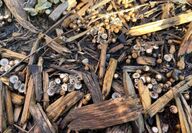Sorted by date Results 1 - 8 of 8

There is truly so much beauty and wonder in nature if we take a few minutes in our busy schedules to appreciate it. I was looking at a tree last month when there was much more moisture, and something in the mulch caught my eye. No, it wasn't an insect, not this time anyway. It was a type of fungus called bird's nest fungi. Bird's nest fungi are small. You might easily step on them in the garden without noticing it. They range in size but are usually under one-quarter inch in width. I learned...

Last year, I seeded a small patch of bee lawn to see how it would work in my yard. It is an out-of-the-way area tucked behind a shed and spruce tree that I don't like to mow. I wanted to try it out before I committed to converting more areas of the backyard into a bee lawn. A bee lawn combines flowering plants for pollinators with low maintenance turfgrass. Not just any flowering plants can be used for a bee lawn. The flowering plants have to be good sources of pollen and nectar for...

Peonies are one of my favorite spring flowers. I have four plants and I can't wait until my house is filled with pink and white peony blossoms. If you don't have them in your landscape, I encourage you to find space to grow a peony. Peonies are herbaceous perennials that grow three to four feet tall and wide. Peonies can grow for many years and are often found still growing around old houses and in old cemeteries. There is a common shrub form of the peony, mentioned above, as well as tree forms...
Peat moss is a gardener’s go-to product for fixing almost any soil issue. Growing plants in a container? Use a peat-base, soilless mix. Need to loosen-up your soil? Add peat moss. Want more water holding capacity? Add peat moss. You get the idea. Gardeners, do you ever take a moment to wonder where this miracle product comes from? Peat moss is appropriately named, as it is decomposed moss. Peat moss forms in wet, low-lying areas such as bogs and wetlands. These peat wetlands are found in cool climates. Main peat-producing areas are located i...
As most gardeners are, I am overly excited at planting time. If I have the room and the weather cooperates, I usually plant way more than I can eat and preserve. One never knows what the growing season will bring, and you don’t want to be short on vegetables! One vegetable that I have learned the hard way not to over plant is zucchini. Zucchini is a member of the Cucurbitaceae or gourd family. This family includes pumpkins, squashes, cucumbers and melons. Zucchini is also called summer squash as it is harvested when it is immature and the s...
Frequently as gardeners we concentrate efforts on our plants, focusing on what varieties will give us the best tasting produce or a beautiful landscape. However, I encourage all gardeners to “dig” a little deeper and concentrate some of our efforts on the soil. In the spirit of getting our hands dirty, let’s dig into carbon and soil organic matter. What is carbon? Carbon gets a reputation as being bad for us and the environment. While that is true for increasing levels of carbon dioxide in our atmosphere, carbon is necessary as a build...
If you are reading this article, I hope you have stuck with me and listened to my advice on starting seeds. By now, you may have started a few seeds and your other seeds are waiting patiently in the wings. My oregano and thyme have been seeded, and I am patiently awaiting the first seedlings to emerge. While we are waiting to start more seeds, let’s discuss watering and fertilizing your seedlings. Watering seedlings indoors can be somewhat more complicated than watering plants in the garden or in containers outdoors. Indoors, soil moisture l...
Last month, I discussed getting ready for starting garden seeds. Hopefully, you have your supplies ready to go. Now the most important supply you need is patience! Sadly, it isn’t time for most garden seeds to be started. It is still too early. Why must I wait, you ask? Vegetable plants are not meant to be grown inside for extended periods of time. Plants use sunlight to convert oxygen and water into carbohydrates or energy. This process is called photosynthesis and happens inside chlorophyll molecules in plants. If plants do not have enough s...